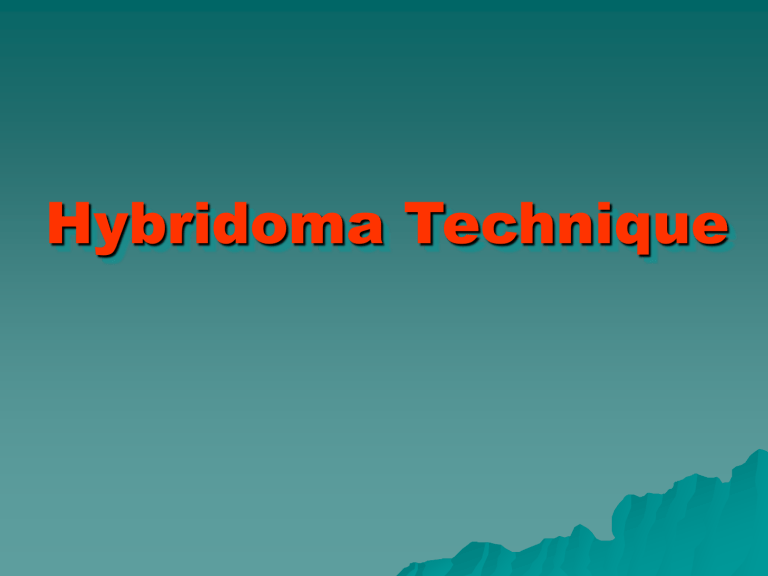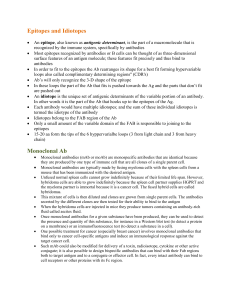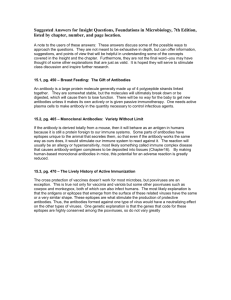Humanized Monoclonal Antibodies

Hybridoma Technique
In 1975 , Kohler and Milstein first fused lymphocytes to produce a cell line which was both immortal and a producer of specific antibodies. The two scientists were awarded the Nobel Prize for
Medicine in 1984 for the development of this "hybridoma." The value of hybridomas to the field was not truly appreciated until about 1987, when MAbs were regularly produced in rodents for diagnostics.
In a specific immune response, only those T and B cells that can bind to the antigens of the pathogen are selected to participate in the response.
Mixture of T and B cells with different antigen specificities
An antigen with 2 epitopes
- red epitope, blue epitope
Proliferation of cells with receptors capable of binding epitopes of the antigen
Clonal selection of lymphocytes during the specific immune response
Polyclonal antibodies:
If an animal is immunized with a protein, a wide array of B cells will be stimulated to produce anti-protein antibodies.
Antibodies may be made to a number of different epitopes of the protein.
Even antibodies that bind to the same epitope may have different antigen-binding sites and bind the epitope with different affinity.
The mixture of antibodies produced in response to an antigen are referred to as polyclonal antibodies (they are produced by many different clones of B cells).
Protein
Epitopes
Immunize
Immune Response
Antibodies
A mixture of antibodies - all bind to epitopes of the original antigen. Some bind with higher affinity than others.
Polyclonal antibodies
Polyclonal antibodies:
Polyclonal antibodies are a mixture of antibodies with different antigen binding sites that may bind to different epitopes or antigens of the immunizing agent with varying affinities. They may be of different antibody classes.
The serum obtained from an immunized animal is referred to as a polyclonal antiserum.
A polyclonal antiserum contains antibody to different epitopes and different antigens that were present in the immunizing inoculum.
Affinity chromatography - antibody purification.
Antigen can be bound to the support matrix in order to purify antigen-specific antibody from a polyclonal antiserum.
From http://users.rcn.com/jkimball.ma.ultranet/BiologyPages/A/AffinityChrom.html
Polyclonal antibodies
(Polyclonal antiserum)
B B B B B B B B
Harvest Ab
Monoclonal antibodies
Hybridomas Technique
- B lymphocytes can mutate into tumor cells that result in a type of cancer termed myeloma.
- Myeloma cells become “immortal” and will grow indefinitely in culture.
- Fusion of a single activated B cell and a myeloma cell will create a hybridoma that can grow indefinitely in culture.
Myeloma cells
FUSE Hybridoma cells
Secrete antibody but don't grow in tissue culture
Grow indefinitely in cell culture but don't secrete the desired antibody
Grow indefinitely in cell culture AND secrete antibody
Harvest Ab
Monoclonal antibodies
Monoclonal antibodies:
Antibodies produced from a single clone of B cells.
Produced by fusing a B cell secreting the desired antibody with a myeloma cell capable of growing indefinitely in tissue culture.
Monoclonal antibodies all have identical antigen-binding sites. Thus they all bind to the same epitope with the same affinity. They are all of the same antibody class (isotype).
Inverted microscope
Hybridoma Selection
The “HAT Trick”
Myeloma cells have been genetically engineered such that they can not use hypoxanthine, aminopterin, and thymidine
(HAT medium) as a source for nucleic acid biosynthesis and will die in culture.
Only B cells that have fused with the engineered myeloma cells will survive in culture when grown in HAT medium.
Practical steps in monoclonal antibody production:
1) Immunize animal
2) Isolate spleen cells (containing antibody-producing B cells)
3) Fuse spleen cells with myeloma cells (e.g. using PEG - polyethylene glycol)
4) Allow unfused B cells to die
5) Add aminopterin to culture to kill unfused myeloma cells
6) Clone remaining cells (place 1 cell/well and allow each cell to grow into a clone of cells)
7) Screen supernatant of each clone for presence of the desired antibody.
8) Grow the chosen clone of cells in tissue culture indefinitely.
9) Harvest antibody from the culture supernatant.
10) (If you’re a biotech company) charge about $1,000-$2,000 per mg.
Kuby Figure 4-22
Rasing ascitic fluid
In vitro
cultivation
Produced by:
Bind to:
Antibody class:
Polyclonal antibodies Monoclonal Antibodies
Many B cell clones A single B cell clone
Multiple epitopes of all antigens used in the immunization
A mixture of different
Ab classes (isotypes)
A single epitope of a single antigen
All of a single Ab class
Ag-binding sites: A mixture of Abs with different antigen-binding sites
Potential for cross-reactivity: High
All Abs have the same antigen binding site
Low
Uses
M easuring protein and drug levels in serum
T yping tissue and blood
I dentifying infectious agents
I dentifying clusters of differentiation for the classification and follow-up therapy of leukemias and lymphomas
I dentifying tumor metastasis
I dentifying and quantifying hormones
I mmunoaffinity Purification
in vitro
Tumor diagnosis in vivo
99m Tc-mAb
Affinity chromatography:
1.
Bind antibody to a support matrix (e.g. sepharose gel)
2.
Add protein mixture - antigen binds to antibody on support
3.
Wash to remove unbound material
4.
Lower pH - antibody releases the antigen - which is now free of contaminants
Figure 6.24
Affintity chromatography - protein elution profile
From http://ntri.tamuk.edu/fplc/pursammat.html
Potential Future Uses:
The remarkable specificity of antibodies makes them promising agents for human therapy.
Imagine, for example, being able to make an antibody that will bind only to the cancer cells in a patient coupling a cytotoxic agent (e.g. a strong radioactive isotope) to that antibody, and then giving the complex to the patient so it can seek out and destroy the cancer cells (and no normal cells).
Humanized Monoclonal Antibodies
Mouse monoclonal antibodies have been genetically engineered to replace all of the antibody molecule with human counterparts except the hypervariable regions directly involved with antigen binding.
Humanized monoclonal antibodies are currently be tested in human clinical trials.
Genetic engineering methods can be used to modify monoclonal antibodies e.g. creation of “humanized” monoclonal antibodies.
Figure 6.21
Antibodies of single specificity (monoclonal) can be obtained by cloning the appropriate heavy and light chain genes.
Figure 6.22
Engineering to create “immunotoxins”
Figure 6.23d




